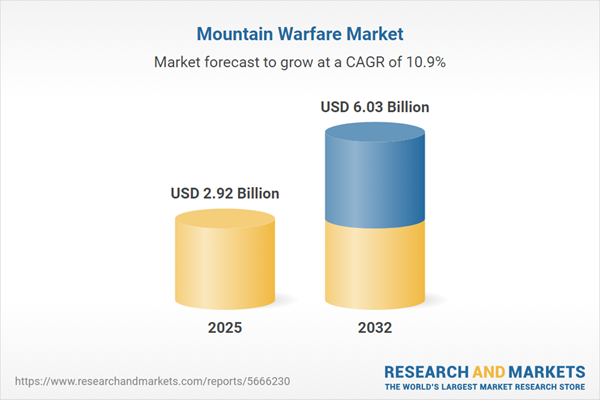Speak directly to the analyst to clarify any post sales queries you may have.
The mountain warfare market continues to evolve as defense agencies seek modern, integrated solutions designed for the complexities of high-altitude terrain. Senior decision-makers require actionable insights to optimize procurement and readiness in these demanding operational contexts.
Market Snapshot: Mountain Warfare Market Growth Outlook
The mountain warfare market is entering a phase of robust growth, supported by ongoing global defense investment and a strong upward trajectory in market size and compound annual growth rate (CAGR) projected through 2032. Senior leaders are driving targeted funding towards sensor-enabled systems, modernized protective gear, and state-of-the-art reconnaissance and logistics platforms. Advancement is visible through widespread adoption of digital command technologies, sophisticated operational protocols, and force multipliers built for rough, elevated environments. The integration of these capabilities encourages defense stakeholders to continuously enhance mission agility and adaptability in mountain theaters.
Scope & Segmentation: Strategic Alignment for Stakeholders
This analysis delivers clarity on segment-specific trends, enabling senior leadership to align resources and make data-driven decisions for high-operational-impact investments. The segmentation is characterized as follows:
- Product Type: Advanced insulated clothing, tactical footwear for extreme climates, protective equipment for high altitudes, secure navigation and communications solutions, electro-optic surveillance, robust vehicles for mountainous deployment, modular weapon systems, and durable mission field gear.
- Application: Tactical mission planning, logistical operations in challenging terrain, direct combat and defense maneuvers, unmanned surveillance, high-altitude intelligence activities, and specialized reconnaissance into inaccessible areas.
- End User: Infantry brigades, rapid deployment forces, specialized mountain units, paramilitary organizations skilled in high-altitude conditions, and special operations teams assigned to complex terrains.
- Platform: Aircraft optimized for mountain operations, flexible-use helicopters, resilient ground vehicles, unmanned aerial systems for surveillance and resupply, and autonomous vehicles designed for rugged settings.
- Geography: Insight into regional drivers across the Americas (U.S., Canada, Mexico), EMEA (UK, Germany, Russia, Saudi Arabia), and Asia-Pacific (China, India, Japan, Australia, and others).
- Technologies: High-precision sensor integration, autonomous reconnaissance, satellite communications resilience, modular weaponry, adaptive support assets, and real-time data-driven logistics for mountain operations.
- Industry Stakeholders: Major defense manufacturers such as Lockheed Martin, Raytheon Technologies, General Dynamics, BAE Systems, Thales, and other influential companies shaping procurement strategies and technology adoption.
Key Takeaways: Strategic Insights for Senior Leaders
- Sensor-based surveillance and integrated intelligence platforms are reshaping situational awareness, supporting informed decision-making at all levels in mountainous environments.
- Continuous innovation in protective gear, logistics assets, and digital command systems directly addresses the operational demands of extreme elevation and unpredictable climates.
- Distinctive regional priorities emerge, with North America focusing on mobile force readiness, EMEA strengthening network and sensor integration, and Asia-Pacific prioritizing autonomous systems expansion.
- Investments in modular and scale-ready platforms enhance operational agility and reinforce secure communication, enabling rapid shifts according to mission requirements in diverse mountain settings.
- Interoperable infrastructure and standardization streamline coalition operations, enhancing cross-border collaboration in multinational mountain warfare scenarios.
United States Tariffs: Impact on Procurement Strategies
Evolving United States tariff regulations have prompted defense organizations to reinforce domestic supply chains, resulting in stronger partnerships with regional suppliers. This strategic direction encourages consistent and interoperable solutions among market participants invested in mountain warfare procurement and readiness.
Methodology & Data Sources
This report utilizes both qualitative and quantitative research, drawing from executive interviews with leading defense experts and planners. Validation processes combine authoritative defense documents, recognized white papers, and direct leader perspectives to deliver reliable and decision-ready insights.
Why This Report Matters for Mountain Warfare Stakeholders
- Supports tailored procurement and innovation by aligning solutions with high-altitude mission requirements and defense modernization priorities.
- Provides actionable regional insight and benchmarks to help leaders strategically allocate resources and manage operational risk within specialized environments.
- Drives optimization of force readiness and resilience to meet the multifaceted challenges of mountain operations.
Conclusion
This analysis delivers the strategic guidance senior leadership requires to enhance readiness, streamline procurement, and maintain operational effectiveness in the demanding domain of mountain warfare.
Additional Product Information:
- Purchase of this report includes 1 year online access with quarterly updates.
- This report can be updated on request. Please contact our Customer Experience team using the Ask a Question widget on our website.
Table of Contents
3. Executive Summary
4. Market Overview
7. Cumulative Impact of Artificial Intelligence 2025
Companies Mentioned
The companies profiled in this Mountain Warfare market report include:- Lockheed Martin Corporation
- Raytheon Technologies Corporation
- General Dynamics Corporation
- BAE Systems plc
- Leonardo S.p.A.
- Thales S.A.
- Rheinmetall AG
- Saab AB
- Elbit Systems Ltd.
- Hanwha Aerospace Co., Ltd.
Table Information
| Report Attribute | Details |
|---|---|
| No. of Pages | 195 |
| Published | October 2025 |
| Forecast Period | 2025 - 2032 |
| Estimated Market Value ( USD | $ 2.92 Billion |
| Forecasted Market Value ( USD | $ 6.03 Billion |
| Compound Annual Growth Rate | 10.9% |
| Regions Covered | Global |
| No. of Companies Mentioned | 11 |









